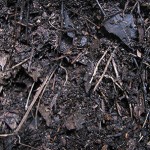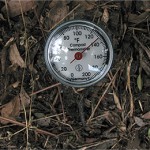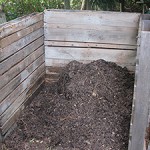The Compost Pile
- "Compost Breaking Down Nicely"
- "Over 130 degrees f."
- "Pallet Compost Bin"
I have been for many years creating compost for my vegetable garden by composting directly into fallow sections. I garden in South Florida. Our growing seasons are upside down here. Most of our vegetable growing is done in the winter when the humidity is down, and our lowest temperatures rarely make a frost. Summertime when it is hot and wet is a great time to compost manure leaves and kitchen wastes right into fallow garden sections. I also keep a few mountainous piles of courser garden wastes made from large cuttings, fallen branches and palm fronds, and weeds. These piles are composting passively and some have beautiful plant volunteers growing on them. They exist because I am fortunate to have the space, and I refuse to add any garden waste to the landfill. These piles are many years old, and I can dig beneath them for a bucket or two of loamy soil for my plants. Passive composting is slow. I don’t cut or shred things put there, and I do not turn that compost. It breaks down slowly, the way it would in the forest.
I have recently started a third style of composting in bins. I built the bins from wooden shipping pallets. My local feed store passed me some pallets that were too beat to turn back to shipping. They make great sides for my compost bins. I am learning to compost this way in order to have more compost faster. Ha Ha! I have a friend in the Canadian Rockies who writes about how hard it is to make compost quickly. I understand. She has a very nice site and some good blogs. She is The-Compost-Gardener.com. I found her because I was doing a search on my business name here in Florida also The Compost Gardener. I like her vibe and don’t mind sharing a name with her.
I have been learning about the quickest way to compost, and I read that if done properly I can have finished compost in a few weeks. Wow that is fast! I put together 3 pallet composters and I filled those composters with ground up leaves, some kitchen waste and various manures. The ratio is supposed to be carbon (brown things like brown leaves) /nitrogen (green things like kitchen waste, manure, or grass clippings) 4 or 5 to 1. Everything looked right to me, but nothing happened.
I decided to get a compost thermometer, and I did more reading. I read about activators but decided against adding one. I knew this could be done without. Although, once my compost comes ready to be harvested I will leave a little behind to start or activate the next pile.
I read that a compost pile too wet or too dry, or without enough oxygen will not compost rapidly. A compost pile should be about 50% moisture, and it should be about 4’x4’x4′. I began turning the piles to aerate them, and I added more leaves and manure to one to make it even bigger. As I mixed in the leaves I wet them, mixed some more and wet more. I have been plunging my thermometer into the piles each day, and yesterday one pile heated up to 105. I checked it today and it was up to 110 degrees f. (43 degrees c.) I am psyched. I hope tomorrow the temperature will go higher. It should go between 120 (48.8c) and 140 (60 c) degrees fahrenheit in order to sterilize weed seeds and some of the bacteria. If it doesn’t I will turn the pile again. I will also continue to turn the other two until I get some heat action.
Many weeks have passed now. That compost pile that went to 110 degrees f. never went above. It is very dark now and breaking down in spite of not having met my heat expectations. I have been turning all three piles about once a week to aerate them and making sure they stay moist enough. I combined the other two compost piles into one bin leaving just a little broken down material in the empty bin.
Last week after the flooding from Tropical Storm Faye my friend Wyn from Creature Safe Place gave me two bags of spoiled Sweet Feed which is a ground grain pellet mixture for horses goats and sheep. The Sweet Feed bags had begun to mold and so could not be used for feed, but for compost? Yes ! I mixed the sweet feed in the nearly empty bin with the compost that was left there. I piled shredded leaves and grass mix on top wetting it pretty regularly. That pile has heated to 130 degrees fahrenheit (54 degrees c.) A reason to love spoiled pellet feed grain mixes! Once it cools down I will turn the pile and make sure it is moist enough. I can see that these piles dry out pretty quickly even with our very humid and often rainy weather.
I have been learning not only from reading, but also from observing my compost piles and my garden sections that have direct compost systems going. What I am learning is that expecting the composting process to complete itself from start to finish in just a few weeks is probably not a reasonable expectation for most of us home composters. As in all things of the garden there is no cramming. Make your plans accordingly, and follow your schedules so that you can have good home made compost for your garden when planting time comes, and if you should be caught with your pants down at planting time then run out and get you some composted cow manure from the store, and vow to do better next year!
I think along with making sure the compost is moist enough having enough green or nitrogen packed material is very important in order to get the desirable high temperatures. I will therefore be more generous with the manure or green elements in my compost bins. Compost will make itself with or without the high temperatures, but high temps. help to destroy original bacteria that might be present in the manure from the gut of the animal, and any weed seeds in the grasses hay or leaves, and the heat speeds the breakdown of the compost so it is an important process if you want compost as quickly as possible. The microbial life of a compost pile is fascinating, and no matter how hot it gets it is never sterile. The microbial life of a compost pile deserves its own article. Please watch for that.




2 Responses
Hey, Adina! I’m checking back with this informational post as I am preparing my first compost pile. We are following your lead with the pallets…straight from our local feed store. I’m excited to get started, so am brushing up on all of your posts. Of course, when I post about my project, I will include links to your site and articles. Miss your bunny blessings, though. I could really use them! The soil at my new property is honestly sand…nothing else. Without enhancing the ground, it is so difficult to grow anything that is not native to this specific micro climate.
I’ll be checking back with you often! Take care!
Hi Kimberly, It is good to hear from you. I hope you and your family are well. I am sure a new garden and a new soil situation are challenging. Things always go slowly at first, but once you begin piling organic material onto your soil it will begin to develop some life, and you will have loamy soil, and lots of compost. Please be sure to check out my most recently written compost article. It documents the changes I have made in my composting practices since this article was written.
Thanks for your comment and for future links. Best of luck with the compost. May it attract mad invertebrates!